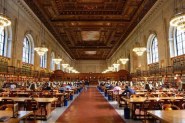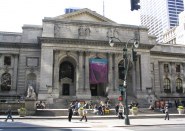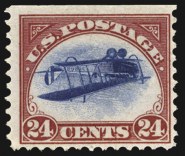Owner Biography
New York Public Library
According to their website, by the second half of the 19th century, New York had already surpassed Paris in population and was quickly catching up with London, then the world's most populous city. Fortunately, this burgeoning and somewhat brash metropolis counted among its citizens men who foresaw that if New York was indeed to become one of the world's great centers of urban culture, it must also have a great library.
Prominent among them was one-time governor Samuel J. Tilden (1814-1886), who upon his death bequeathed the bulk of his fortune -- about $2.4 million -- to "establish and maintain a free library and reading room in the city of New York."
At the time of Tilden's death, New York already had two libraries of considerable importance -- the Astor and Lenox libraries -- but neither could be termed a truly public institution in the sense that Tilden seems to have envisioned.
By 1892, both the Astor and Lenox libraries were experiencing financial difficulties. The combination of dwindling endowments and expanding collections had compelled their trustees to reconsider their mission. At this juncture, John Bigelow, a New York attorney and Tilden trustee, devised a bold plan whereby the resources of the Astor and Lenox libraries and the Tilden Trust would be combined to form a new entity, to be known as The New York Public Library, Astor, Lenox and Tilden Foundations.
The site chosen for the home of the new Public Library was the Croton Reservoir, a popular strolling place that occupied a two-block section of Fifth Avenue between 40th and 42nd Streets. Following an open competition among scores of the city's most prominent architects, the relatively unknown firm of Carrère and Hastings was selected to design and construct the new library. The result, regarded as the apogee of Beaux-Arts design, was the largest marble structure ever attempted in the United States. Before construction could begin, however, some 500 workers had to spend two years dismantling the reservoir and preparing the site. The cornerstone was finally laid in May 1902.
Work progressed slowly but steadily on the monumental Library which would eventually cost $9 million to complete. During the summer of 1905, the huge columns were put into place and work on the roof was begun. By the end of 1906, the roof was finished and the designers commenced five years of interior work. In 1910, 75 miles of shelves were installed to house the immense collections.
More than one million books were set in place for the official dedication of the Library on May 23, 1911—some 16 years to the day since the historic agreement creating the Astor, Lenox, and Tilden Foundations had been signed. The ceremony was presided over by President William Howard Taft and was attended by Governor John Alden Dix and Mayor William J. Gaynor.
The following morning, New York's very public Public Library officially opened its doors. The response was overwhelming. Between 30,000 and 50,000 visitors streamed through the building the first day it was open.
On February 6, 1925, Benjamin K. Miller donated his virtually complete collection of United States stamps to the New York Public Library, with the stipulation that it remain on permanent view. The terms were followed until May 9, 1977, when part of the collection was stolen from its display case at the library.
Prominent among them was one-time governor Samuel J. Tilden (1814-1886), who upon his death bequeathed the bulk of his fortune -- about $2.4 million -- to "establish and maintain a free library and reading room in the city of New York."
At the time of Tilden's death, New York already had two libraries of considerable importance -- the Astor and Lenox libraries -- but neither could be termed a truly public institution in the sense that Tilden seems to have envisioned.
By 1892, both the Astor and Lenox libraries were experiencing financial difficulties. The combination of dwindling endowments and expanding collections had compelled their trustees to reconsider their mission. At this juncture, John Bigelow, a New York attorney and Tilden trustee, devised a bold plan whereby the resources of the Astor and Lenox libraries and the Tilden Trust would be combined to form a new entity, to be known as The New York Public Library, Astor, Lenox and Tilden Foundations.
The site chosen for the home of the new Public Library was the Croton Reservoir, a popular strolling place that occupied a two-block section of Fifth Avenue between 40th and 42nd Streets. Following an open competition among scores of the city's most prominent architects, the relatively unknown firm of Carrère and Hastings was selected to design and construct the new library. The result, regarded as the apogee of Beaux-Arts design, was the largest marble structure ever attempted in the United States. Before construction could begin, however, some 500 workers had to spend two years dismantling the reservoir and preparing the site. The cornerstone was finally laid in May 1902.
Work progressed slowly but steadily on the monumental Library which would eventually cost $9 million to complete. During the summer of 1905, the huge columns were put into place and work on the roof was begun. By the end of 1906, the roof was finished and the designers commenced five years of interior work. In 1910, 75 miles of shelves were installed to house the immense collections.
More than one million books were set in place for the official dedication of the Library on May 23, 1911—some 16 years to the day since the historic agreement creating the Astor, Lenox, and Tilden Foundations had been signed. The ceremony was presided over by President William Howard Taft and was attended by Governor John Alden Dix and Mayor William J. Gaynor.
The following morning, New York's very public Public Library officially opened its doors. The response was overwhelming. Between 30,000 and 50,000 visitors streamed through the building the first day it was open.
On February 6, 1925, Benjamin K. Miller donated his virtually complete collection of United States stamps to the New York Public Library, with the stipulation that it remain on permanent view. The terms were followed until May 9, 1977, when part of the collection was stolen from its display case at the library.



